
The national emblem of Cape Verde contains a circle within which is written the name of the nation in Portuguese. Within the circle are a torch and triangle, symbols of freedom and national unity. At the top of the shield is a plumbob, a symbol of righteousness; three chain links are at the bottom. This emblem replaces the earlier variant with the seashell that had been in use since independence. The current emblem was adopted in 1992.

The coat of arms of Anguilla is the heraldic device consisting of a shield charged with three orange dolphins leaping over the sea. Adopted in 1990, it has been the coat of arms of Anguilla since that year. The escutcheon is featured on the flag of the territory.

The coat of arms of Antigua and Barbuda was designed in 1966 by Gordon Christopher. It was officially introduced on 16 February 1967. The symbolism of the arms is more complex than that found on the flag of Antigua and Barbuda, but many elements are similar.

The coat of arms of the Bahamas contains a shield with the national symbols as its focal point.
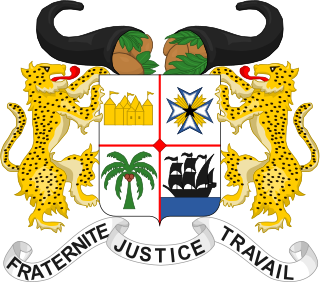
The coat of arms or national seal of Benin, originally introduced in 1964, was readopted in 1990 after being replaced in 1975.

The coat of arms of Bosnia and Herzegovina was adopted in 1998, replacing the previous design that had been in use since 1992 when Bosnia and Herzegovina gained independence. It follows the design of the national flag. The three pointed shield is used to symbolize the three major ethnic groups of Bosnia, as well as allude to the shape of the country.

The flag of the Cayman Islands consists of a Blue Ensign defaced with the British overseas territory's coat of arms. Adopted in 1959 to supplement the Union Jack and to replace the flag of the Colony of Jamaica, it has been the flag of the Cayman Islands since the territory was granted self-government that year. The design of the present flag entailed removing the white disc and outlining the coat of arms with a white trim, although the previous version is often used in an official capacity. The Cayman Islands' flag is similar to the flags of eight other British Overseas Territories, which are also Blue Ensigns with their respective coats of arms.
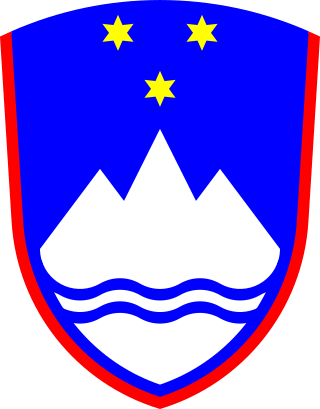
The Slovene coat of arms consists of a red bordered blue shield on which there is a stylised white Mount Triglav, under which there are two wavy lines representing the sea and the rivers of the country. Above Mount Triglav, there are three golden six-pointed stars representing the Counts of Celje. It was designed in 1991 by Marko Pogačnik and adopted on 24 June 1991.

Every sultan of the Ottoman Empire had his own monogram, called the tughra, which served as a royal symbol. A coat of arms in the European heraldic sense was created in the late 19th century. Hampton Court requested from the Ottoman Empire a coat of arms to be included in their collection. As the coat of arms had not been previously used in the Ottoman Empire, it was designed following this request, and the final design was adopted by Sultan Abdul Hamid II on 17 April 1882.

The coat of arms of Victoria is the official heraldic symbol of the Australian state of Victoria. Victoria was the second state of Australia to gain arms, granted on 6 June 1910 by royal warrant of King George V. The state had been named in 1851 after his grandmother, who was in reign at the time. The final version of the arms was granted 28 March 1978 in the royal warrant issued by Queen Elizabeth II.

The coat of arms of Portugal is the main heraldic insignia of Portugal. The present model was officially adopted on 30 June 1911, along with the present model of the Flag of Portugal. It is based on the coat of arms used by the Portuguese Kingdom since the Middle Ages. The coat of arms of Portugal is popularly referred as the Quinas.

The coat of arms of the British Virgin Islands consists of a green escutcheon (shield) charged with a woman in a white dress and gold-coloured sandals, holding a lit golden oil lamp and surrounded by eleven other golden lamps. Adopted shortly after the islands became a Crown colony, it has been the coat of arms of the British Virgin Islands since 1960. The escutcheon dates from the early 19th century and is featured on the flag of the territory. The woman and the lamps represent Saint Ursula and her companions, the namesake of the islands.
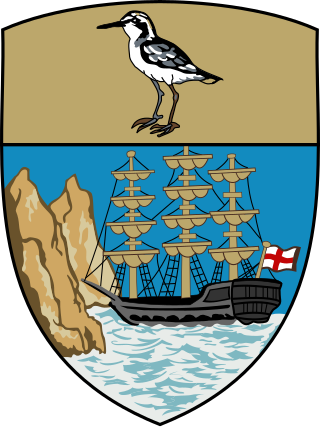
The coat of arms of Saint Helena, part of the British Overseas Territory of Saint Helena, Ascension and Tristan da Cunha, was authorised on 30 January 1984.
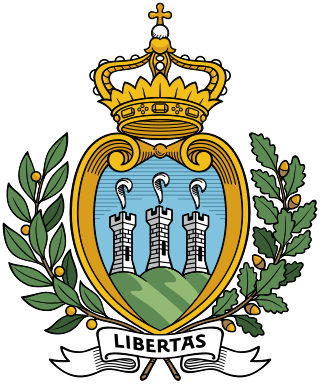
The coat of arms of San Marino probably originated in the fourteenth century. The official establishment took place on 6 April 1862 by a Decree of the Supreme Council; the same act introduced the crown on top of the shield.

The flag of Sint Maarten consists of a white triangle situated at the hoist charged with the constituent country's coat of arms, along with two horizontal bands of red and blue. Adopted in 1985 shortly after the territory was granted a coat of arms, it has been the flag of Sint Maarten since 13 June of that year. Since the dissolution of the Netherlands Antilles on 10 October 2010, it has been the sole flag used in the constituent country.

The coat of arms of Saint Pierre and Miquelon is the official heraldic symbol of the French overseas collectivity of Saint Pierre and Miquelon. It was designed by Léon Joner.

The flag of Wisconsin is the official flag of the U.S. state of Wisconsin. The flag was first adopted in 1863, and was modified in 1979. It is a blue flag charged with the state coat of arms of Wisconsin.
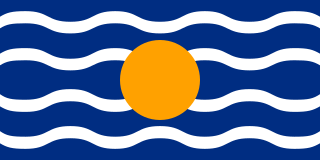
The flag of the West Indies Federation was used between 1958 and 1962. It bore four equally spaced narrow white stripes with a large orange-gold disc over the middle two lines in the center of the flag, undulating horizontally across a blue field representing the Caribbean Sea and the sun shining upon the waves. The flag was originally designed by Edna Manley. The flag is shown as 1:2; the upper two white stripes reflect the lower ones.
The national symbols of Saint Lucia are the symbols that this Caribbean nation identify with. The most recognizable national symbols of Saint Lucia are the flag and the coat of arms.
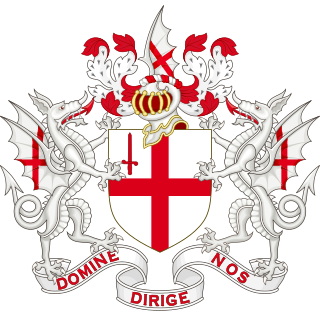
The coat of arms of the City of London is the official coat of arms of the City of London, which is one of a number of cities and boroughs in Greater London.



















